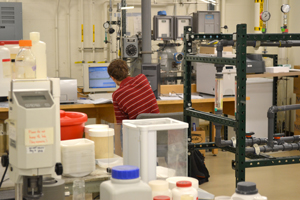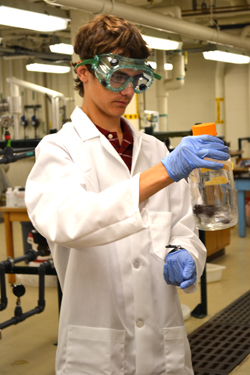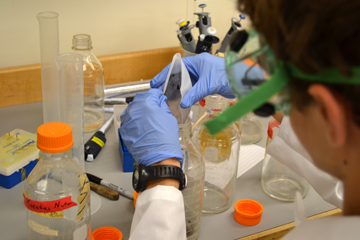High School Student Experiences Life in an Illinois Lab
July 2, 2012

Nathan Beauchamp working in the Unit Operations Lab at Rodger Adams Laboratory.
Nathan Beauchamp jangles the key from his pocket, unlocks the double door and reaches towards the four light switches wrapped around the adjacent wall. The 15-year-old flips the lights with the blind cool only muscle memory can foster. The Unit Operations Lab in the basement of Roger Adams Laboratory at the University of Illinois bursts awake.
Beauchamp is tired today—he stayed up late completing a poster he will present on Friday while explaining his research in the field of 3D printing—and walks to his computer more laboriously than usual.
For the past four weeks, Beauchamp has called this basement lab his own. Working under the guidance of Dr. Jerrod Henderson, Beauchamp has been exploring the impact of dyes on cell growth. His closest companions in the lab have been Sunset Yellow and Oil Red EGN. Those dyes are the subjects of Beauchamp's research. He is only in the preliminary stages, but early indications are that red does not hinder cell growth at all. Yellow is not as clear.
Right now Beauchamp needs to measure 12 separate control solutions of media, sugar, and dye. Last week he created three different dilutions of each dye, and now he must take two samples from each.
Beauchamp throws on his white lab coat.

Nathan Beauchamp performing research during a summer research experience in an Illinois lab.
Beauchamp works in the northwest corner of the lab. Around him are plaques acknowledging the contributions of corporations such as Clorox and LyondellBassell. Complex machines with complex names fill the room. He does not know what the Rheodrive 5000 or the Bioflo 3000 or the Batch Plate Distillation Column do, but he is sure they are expensive and cool.
Beauchamp mostly works with micropipettes and measuring tubes. He would like to make a relevant discovery, but he holds a conservative mindset of his role in the lab. He is just happy to pick up more lab experience. But sometimes he does imagine the possibilities of his research. A guy over at the Mechanical Engineering Building told him that one day biological 3D printing could be used to build biological robots or even organs—" Which would be hard, of course, due to their complex structure."
Three-dimensional printing does not use ink. The dyes are used to stop light from solidifying the polymer being built. Beauchamp revels in the combination of mechanical, chemical, and bimolecular engineering involved. Early in elementary school, Beauchamp found science cool. He digs math too, but he likes how science focuses more on applications. Three years from now, when the rising junior enters college, he plans to major in a science subject. He is not sure which one yet, but he believes it will be more exciting than a math major.
Science runs in Beauchamp family, but he claims the discovery of his passion as his own. Sure, his dad, the professor emeritus in the School of Music with an electrical engineering background, may have promoted the interest, but Nathan found science himself.
To Nathan, science is at its best when it positively affects peoples' lives. Making money is nice, but life is about pursuing your interests.
Beauchamp is fascinated by the fact that water boils more easily in the mountains than at sea level. He loves that most of matter is nothing more than empty space.
"So when people say, 'Your head is empty,' I say they're right."
Done with the three red dye dilutions, Beauchamp moves on to the yellows. They are much less viscous. The media looks like homemade orange juice with too much water, but it is really a combination of malt extract, yeast extract, and Bacto Pepton. The sugar is simple glucose.
When he isn't marveling at the empty space that holds the universe, Beauchamp plays tennis and chess—only the former of which he considers a sport. He enjoys reading for fun and does not dislike language arts but sees greater opportunities in science.

Beauchamp pours the dye into the solution prior to mixing the dilution.
"This is pretty annoying," Beauchamp says. "I need 1.5 milliliters of this, but the tube does not have a mark for that. Of course, it does mark 2.5 and 3.5 milliliters."
He makes do by measuring one and then 0.5 milliliters. This makes for more cleaning and a slower process. While he does not consider himself patient in other aspects of his life, he takes his time in the lab. While he knows that setbacks and poor results are common in science, he does not expect those in other areas of his life.
"Time to enter the measurements."
Beauchamp strides to a gray box beside his computer and presses a button. A tray pops out, and he places his 12 measurements onto the tray and presses the same button to close it.
Cuhreeeekkk!
"What the heck?"
The measurements must be placed perfectly flat and one corner appears to have caught a hitch. A readjustment does the trick.
"The machine will measure cell growth over a course of twelve hours."
He opens a spreadsheet and enters some numbers. A few more clicks and Beauchamp is ready to wrap up for the day. Just then a message pops up on the screen.
"Additional Information Error."
He doesn't understand. He used the exact same script last time he entered measurements, and it worked fine. Two more unsuccessful tries later, he walks up to Dr. Henderson's office. He returns with the email address of the building's tech support guy.
No matter. The young scientist knows poor results are common and every mistake is a learning opportunity.
Author/Photographer: Philip Johnson, Former I-STEM Communications Intern
More: 8-12 Outreach, High School Research, Student Spotlight, Summer Research, 2012













.jpg)
















